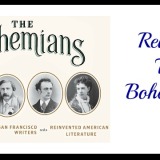
Review: The Bohemians, Ben Tarnoff
Positives
Negatives
Ben Tarnoff’s book The Bohemians: Mark Twain and the San Francisco Writers who Reinvented American Literature offers a fresh look at four authors who came into their own during San Francisco’s burgeoning 1860s. The book chronicles the events that brought together Mark Twain, Bret Harte, Ina Coolbirth, and Charles Warren Stoddard: four authors who had little in common except their desire to create a new and relevant literature for America’s growing western population. The book is well-researched and carefully executed.

Picture of a young Mark Twain. Picture from thedailybeast.com.
Of the authors Tarnoff features, Mark Twain is the only one whose name will be instantly recognized by most readers. Twain’s life has been well-documented, and although the author has been dead for over 100 years, he is still making headlines. Just this past weekend, a plaque was stolen from the famous writer’s grave in Elmira, New York (read more here). Most readers of Twain’s work believe him to have been a jovial man, full of life and determination. But, as Tarnoff explores in his book, Twain was plagued by self-doubt. When Twain first arrived in San Francisco in the early 1860s, his reputation was sketchy at best. Yet, he quickly fell in with Bret Harte, and the two began a friendship that was, in turns, competitive, supportive, and destructive.

Bret Harte always dressed more professionally than his peers, and many even criticized him for his “foppish” attire. Picture from gutenberg.org.
Like Twain, Harte came to San Francisco looking for a fresh start. In March 1860, Harte wrote about the February 26th massacre of the Wiyot Indians near Humboldt Bay close to Uniontown, where Harte worked for the Northern Californian. The massacre of the native women, children, and elderly appalled Harte, who detailed his shock in a scathing editorial that did not endear him to readers. Harte sought refuge in San Francisco, and both he and Twain arrived just in time to see the city explode with a need for engaging writers.
Ina Coolbirth had also arrived in San Francisco to begin anew. A beautiful young woman, Coolbirth had recently escaped an abusive marriage, and she was needing a change of scenery to help her cope with the death of her infant. Regarded as a great beauty, Coolbirth had many admirers, but what she desired most was the acceptance of her poetry. Even as late as the 1860s, not many female American poets had experienced much success with their writing efforts. Most, like Emily Dickinson, were scribbling away furiously, but doing so in silence. Coolbirth wanted to see her poetry in print, and when she was accepted by the other Bohemian authors, she found her place at last.

Ina Coolbirth in 1858. Coolbirth was a descendant of Mormon founder Joseph Smith. Photo from josephsmithsr.com.
Like Coolbirth, Charles Warren Stoddard was trying to find a place where he fit in. A homosexual who did his best to hide this fact, Stoddard found an outlet in his writing. Building on what poet Walt Whitman had done before him, Stoddard wrote about his homosexuality in subtle undertones and veiled expressions. He quickly developed friendships with the other three Bohemian writers, and together they created first the Californian and later the Overland Monthly. Of the four, Stoddard was the only one who was able to maintain his friendships with the others, even over the long distances that began to separate them. Eventually, Harte would decamp for Europe, Twain would find success in the East, and Coolbirth would remain forever tethered to San Francisco. Although he was the petted baby of the group, Stoddard remained a loyal friend to his peers long after Twain and Harte’s friendship fell apart, and after Coolbirth was completely forgotten or ignored by both men.

Charles Warren Stoddard was a budding poet during the early 1860s. Photo from marktwainletters.com.
The Bohemians does a great job of answering just how these four writers managed to leave their indelible stamp on the literary scene. Arriving in San Francisco within just a short time of each other, the four authors found themselves in the unique position to fill a void: a need for literature that captured the true essence of the American West. Yet, they could not agree on what that essence was. Because each came with his or her own experiences, their output differed greatly. However, that was exactly what California was; not a place with an identity that had been long established or was unchangeable, but a developing melting pot with different cultures and classes represented. Where Harte was often harsh with his treatment of San Francisco, Twain was more forgiving in his writings. Thankfully, America needed both their views as well as Coolbirth’s and Stoddard’s. Through them, the rest of the world got a truer sense of what the West was like. The book capitalizes on trying to explain what the West needed at that time. As Tarnoff states, “Poetry and fiction mattered to miners and farmers, merchants and bankers. For them the printed word wasn’t a luxury-it was a lifeline. It fostered a sense of place, a feeling of community, in a frontier far from home.”
Although the book comes in at 319 pages, almost 60 of them are footnotes that document Tarnoff’s research. Truly an academic work, the book does get bogged down in technical language on occasion, making it slow reading from time to time. However, the subjects of Tarnoff’s research are all fascinating individuals, whose lives are interesting enough to keep a reader going.
A solid book, Ben Tarnoff’s The Bohemians should be required reading for serious scholars of Twain and Harte, but it is a good read for anyone interested in learning more about the great literary minds who helped forge a national American identity in literature.
